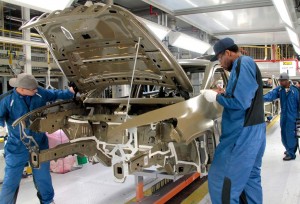
FCA is moving production of the Jeep Cherokee from Ohio to Illinois as part of its production overhaul.
For the first time ever, Big Three auto production will be surpassed by foreign makers and Tesla in the U.S. this year.
According to IHS Markit, the domestic automakers will produce 8.6 million vehicles in 2017 while the other companies will combine to edge out the U.S. makers with 8.7 million new vehicles made.
With the moves by several automakers, such as Volvo, Toyota, Mercedes-Benz and BMW, to add production in the U.S., expect that ratio to remain in favor of the non-U.S. makers.
Just in the last two days, Toyota announced it would invest $373.8 million in five factories as it plans to build hybrid engines and transmissions in the U.S. for the first time. Volvo said on Sept. 25 it’s spending $600 million to double the size of its plant still under construction in South Carolina to build more vehicles.
(Ford planning temporary shutdowns at five North American plants. For the story, Click Here.)
By 2024, Asian and European automakers and Tesla will combine to build about 9.8 million vehicles in North America. General Motors Co, Ford Motor Co and the North American operations of Fiat Chrysler Automobiles NV will combine to build 8.1 million vehicles, down 6% from this year.
In addition to the move by foreign makers to increase their U.S. production levels, Tesla is predicting it will build as many as 500,000 cars a year at its plant in Fremont, California.
(Click Here for more about Toyota’s plans in the U.S.)
Also, domestic makers are increasingly looking outside the U.S. to build vehicles. Factories in China or Mexico producing cars and trucks that used to be assembled in the United States, Langley said. He noted Ford’s decision to shift production of the Focus for North America to a Chinese assembly plant.
Further examples include Ford’s move to import its smallest SUV ever, the EcoSport, from India. General Motors has been importing its Buick Envision ute from China for the past year. It’s a trend that is likely to continue.
(To see more about Volvo expanding its Charleston plant to build XC90s, Click Here.)
The U.S. overall is going to lose production to other NAFTA countries too. Mexico is tracking to increase its share of North American vehicle production, Langley said. It’s expecting to rise to 4.5 million vehicles a year by 2024 from about 4 million vehicles now.

It might help if the Big Three had product planning organizations that did more than decide between velour and leatherette seats.